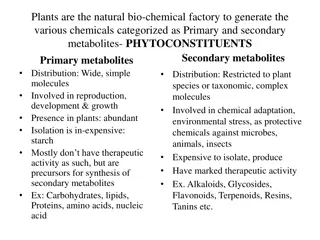Understanding Plant Metabolites: Primary vs. Secondary & Their Biological Functions
Primary metabolites are crucial for plant survival, including sugars and amino acids, while secondary metabolites, like tannins, terpenoids, and flavonoids, play diverse roles such as protection from pathogens, pigmentation, and health benefits. Tannins offer antiviral and antibacterial effects, terpenoids contribute to scents and rubber production, and flavonoids act as antioxidants and aid in nitrogen fixation.
Download Presentation

Please find below an Image/Link to download the presentation.
The content on the website is provided AS IS for your information and personal use only. It may not be sold, licensed, or shared on other websites without obtaining consent from the author. Download presentation by click this link. If you encounter any issues during the download, it is possible that the publisher has removed the file from their server.
E N D
Presentation Transcript
Secondary Metabolites primary metabolites & secondary metabolites. Primary metabolites are essential for the survival of the plant. They include sugars, proteins and amino acids. Secondary metabolites are the compounds which are not directly involved in the normal growth, development & reproduction of the plants. They includes tannins, terpenoids, flavonoids, alkaloids, essential oils & organic acids. Plants produce a variety of compounds that can be divided in to
1. Biological functions of tannins :- Tannins are distributed in species throughout the plant kingdom. They are found in root, stem, leaves, seeds and buds. They are commonly found in the bark of both gymnosperms as well as angiosperms. High concentration is present in bark of oak, Mimosa and chestnut trees. Some families like Boraginaceae, Cucurbitaceae and Papaveraceae contain no tannin. The best known human dietary sources of tannins are tea and wine. Apple juice & grape juice are high in tannins. Coffee pulp also contains low to trace amount of tannins. Tannic acid is used as aroma ingredient in alcoholic drinks. Tannins are also used as clarifying agents in the wine industry & soft drinks or juices. Tannins are used in tanning of leather. They are used in production of wood adhesive. Tannins protect the plant from pathogens. Tannins are effective in enhancing milk production & wool and also effective against gastro-intestinal parasites of animals. Tannins have shown potential antiviral, antibacterial & antiparasitic effects. Tannins can be used as rust inhibitor on the surface of steel.
2. Biological functions of terpenoids :- Terpenoids are made up of isoprene units and are found in all plants. They are the largest group of secondary metabolites & are volatile i.e. they evaporate easily. Terpenoids contribute the scent of Eucalyptus, The flavour of cinnamon, cloves and ginger. Menthol, camphor, turmeric & mustard also contain terpenoid. Isoprene is a gas produced in chloroplasts & released by leaves. It is thought to protect the plant from heat. Taxol from the bark of the Pacific yew tree is used to treat ovarian and breast cancer. Rubber, which is obtained from the latex of plant Hevea brasiliensis, is also terpenoid. The uses of rubber are numerous. The rubber is used in shoes, erasers, tyres, etc.
3. Biological functions of flavonoids :- Flavonoids are a important class of plant secondary metabolites. They are widely distrubuted in plants & have many functions. Over 6,000 unique flavonoids have been identified in research studies. They are highly bioactive and play different roles the health of plants, animals & human health. Fruits and vegetables are the main sources of the flavonoids for humans, alongwith tea and wine. Many flavonoids are shown to have antioxidant activity, caronary heart disease prevention and anticancer, antiviral, antibacterial and anti-inflammatory activity. Flavonoids are most important plant pigments for flower coloration. They produce yellow or red / blue pigmentation in petals, which helps in the attraction of insects for pollination. In higher plants, flavonoids are involved in symbiotic nitrogen fixation. Flavonoids secreted by root of legume plants help to grow Rhizobium & also helps to develop symbiotic relationship with legumes like peas, beans, groundnut, soybean etc. Some flavonoids have inhibitory activity against organisms causing plant diseases, such as Fusarium oxysporum.
4. Biological functions of alkaloids :- Alkaloids are nitrogen containing chemical compounds. They are widely used in medicine. Morphine was the first alkaloid to be found. It comes from the plant Papaver Somniferum (opium poppy). It is used as pain reliver in patients with severe pain level. It is also used as cough suppressant. About 2,500 alkaloids have been isolated so far. They are poorly found in pteridophytes & gymnosperms. They are found in dicot angiosperms of Magnoliales, Ranunculales, Papaveraceae, Leguminosae, Papillinonaceae & Rutaceae. Among monocots, alkaloids are found in Liliaceae & Graminae. The alkaloid cocaine is highly dangerous and additive. However, it is used as anaesthetic. Cocaine derivatives are dangerous when habitually used & they can be deadly. Perhaps most loved & known alkaloid is Caffeine , which come from cocoa, coffee and tea. Caffeine has been thought to reduce the risk of diabetes & heart disease. It is stimulant. The alkaloid quinine is obtained from Cinchona tree. It is antipyretic and antimalerial.
5. Biological functions of essential oils :- o Most vegetative oils are rich in linoleic acid (safflower, sunflower etc.). Alpha linoleic acid is found in green leaves of plants & in selected seeds, nuts & legumes. (particularly flax, rape seed & soy). o Fish oils are rich in omega-3 fatty acids, which are beneficial on infant development, cancer, cardiovascular diseases, mental illness such as depression etc. o Consumption of trans fats, such as those present in partially hydrogenated vegetable oils, are a risk factor for cardiovascular diseases. o Oil is used as essential nutrients much needed by the body. It helps the body detoxify, maintain circulation & improve immune system & health. o Oils are not a food group, but they provide essential nutrients. So, only small amount of oils are recommended. Oils contain essential fatty acids.
6. Biological functions of organic acids :- Organic acids are used in food preservation because they have capacity to inhibit the growth of bacteria. Lactic acid & its salts sodium lactate and potassium lactate are widely used as antimicrobials in food products, particularly meat and poultry. Organic acids have been used successfully in pig production for more than 25 years. The use of organic acids has also been found to be effective in poultry production. Organic acids have preventive effect on the necrotic enteritis in chickens and Escherichia coli infection in pigs.























